University Chemistry Lab: Pipetting Accuracy and Precision Report
VerifiedAdded on 2022/12/12
|9
|1857
|13
Practical Assignment
AI Summary
This practical report details a chemistry experiment focused on assessing the accuracy and precision of pipetting techniques. The aim was to understand how to select the most accurate equipment for volume measurement and to evaluate the precision and accuracy of recorded measurements. The experiment involved pipetting different volumes of water and weighing them to determine the actual volume transferred, with calculations and observations recorded. The results section presents the weights of solutions and the calculated volumes, followed by a discussion of factors influencing pipetting accuracy, such as pipette size, solution viscosity, and technique. The report concludes that the pipette is a precise and accurate tool for liquid measurement, with consistent measurements observed across trials. The report includes an analysis of potential sources of error and recommendations for improving pipetting techniques, as well as answers to questions related to the experiment.

Running head: CHEMISTRY 0
CHEMISTRY
Name of Student
Institution Affiliation
0
CHEMISTRY
Name of Student
Institution Affiliation
0
Paraphrase This Document
Need a fresh take? Get an instant paraphrase of this document with our AI Paraphraser
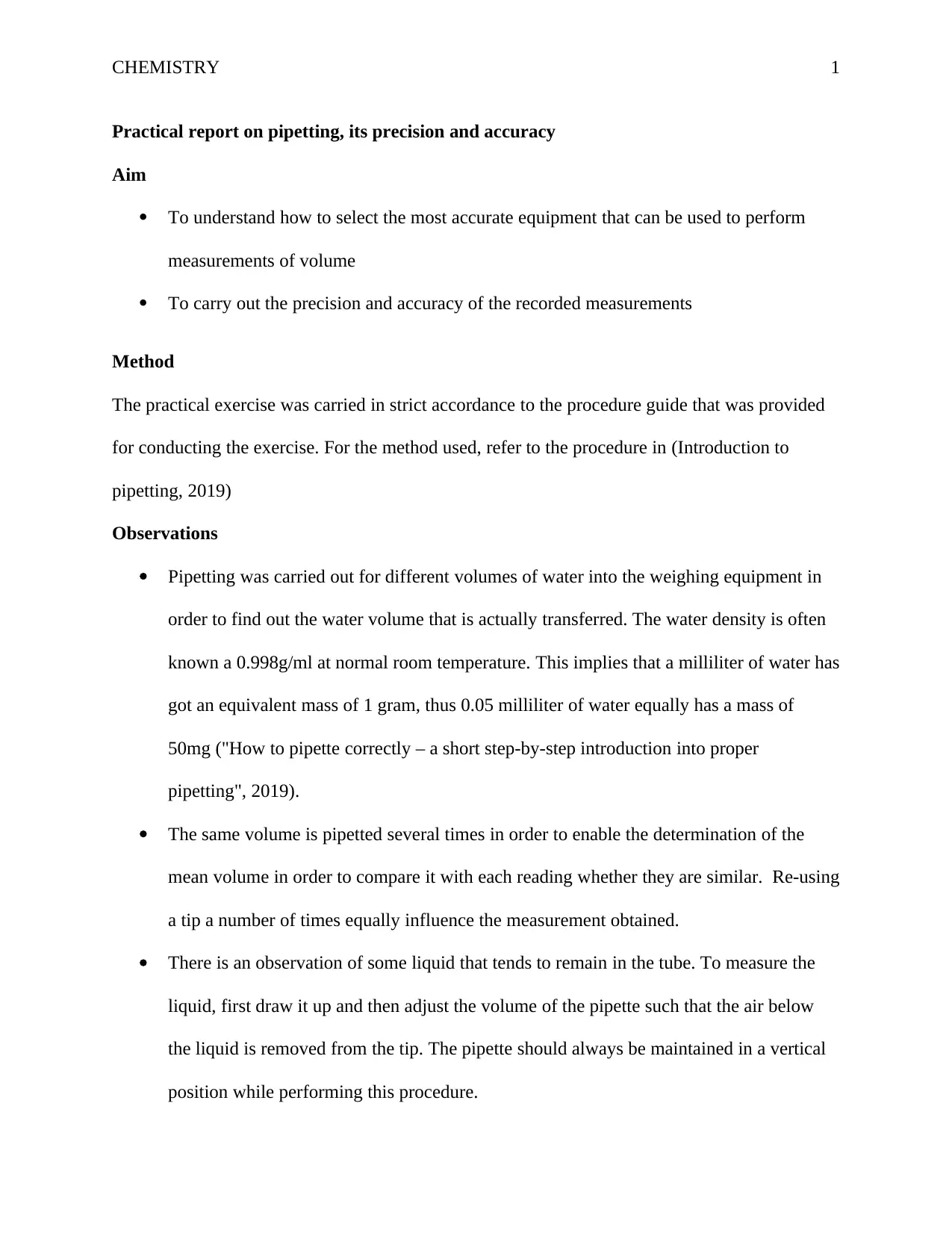
CHEMISTRY 1
Practical report on pipetting, its precision and accuracy
Aim
To understand how to select the most accurate equipment that can be used to perform
measurements of volume
To carry out the precision and accuracy of the recorded measurements
Method
The practical exercise was carried in strict accordance to the procedure guide that was provided
for conducting the exercise. For the method used, refer to the procedure in (Introduction to
pipetting, 2019)
Observations
Pipetting was carried out for different volumes of water into the weighing equipment in
order to find out the water volume that is actually transferred. The water density is often
known a 0.998g/ml at normal room temperature. This implies that a milliliter of water has
got an equivalent mass of 1 gram, thus 0.05 milliliter of water equally has a mass of
50mg ("How to pipette correctly – a short step-by-step introduction into proper
pipetting", 2019).
The same volume is pipetted several times in order to enable the determination of the
mean volume in order to compare it with each reading whether they are similar. Re-using
a tip a number of times equally influence the measurement obtained.
There is an observation of some liquid that tends to remain in the tube. To measure the
liquid, first draw it up and then adjust the volume of the pipette such that the air below
the liquid is removed from the tip. The pipette should always be maintained in a vertical
position while performing this procedure.
Practical report on pipetting, its precision and accuracy
Aim
To understand how to select the most accurate equipment that can be used to perform
measurements of volume
To carry out the precision and accuracy of the recorded measurements
Method
The practical exercise was carried in strict accordance to the procedure guide that was provided
for conducting the exercise. For the method used, refer to the procedure in (Introduction to
pipetting, 2019)
Observations
Pipetting was carried out for different volumes of water into the weighing equipment in
order to find out the water volume that is actually transferred. The water density is often
known a 0.998g/ml at normal room temperature. This implies that a milliliter of water has
got an equivalent mass of 1 gram, thus 0.05 milliliter of water equally has a mass of
50mg ("How to pipette correctly – a short step-by-step introduction into proper
pipetting", 2019).
The same volume is pipetted several times in order to enable the determination of the
mean volume in order to compare it with each reading whether they are similar. Re-using
a tip a number of times equally influence the measurement obtained.
There is an observation of some liquid that tends to remain in the tube. To measure the
liquid, first draw it up and then adjust the volume of the pipette such that the air below
the liquid is removed from the tip. The pipette should always be maintained in a vertical
position while performing this procedure.

CHEMISTRY 2
A fresh tip is used each time in order to avoid cross contamination
In case the pipette is contaminated on its outside, it is first wiped with an ethanol on its
outside ("17 Ways to Stop Pipetting Errors From Ruining Your Experiments - Bitesize
Bio", 2019).
Results
Containers' weights for the 20mL solution are recorded below
Containers' weights for the 10mL solution are recorded below
Calculations
20mL solution
Use the equation, with water – without water to find the mass of water (m).
(C1) 319002 g + 120472 g = (m1) 19.8530 g
20 mL solution Without Water With Water
Container 1 (C1) 120472 g 319002 g
Container 2 (C2) 121829 g 321476 g
Container 3 (C3) 118878 g 317217 g
10 mL solution Without Water With Water
Container 1 (C1) 120472 g 219724 g
Container 2 (C2) 121829 g 221589 g
Container 3 (C3) 118878 g 218356 g
A fresh tip is used each time in order to avoid cross contamination
In case the pipette is contaminated on its outside, it is first wiped with an ethanol on its
outside ("17 Ways to Stop Pipetting Errors From Ruining Your Experiments - Bitesize
Bio", 2019).
Results
Containers' weights for the 20mL solution are recorded below
Containers' weights for the 10mL solution are recorded below
Calculations
20mL solution
Use the equation, with water – without water to find the mass of water (m).
(C1) 319002 g + 120472 g = (m1) 19.8530 g
20 mL solution Without Water With Water
Container 1 (C1) 120472 g 319002 g
Container 2 (C2) 121829 g 321476 g
Container 3 (C3) 118878 g 317217 g
10 mL solution Without Water With Water
Container 1 (C1) 120472 g 219724 g
Container 2 (C2) 121829 g 221589 g
Container 3 (C3) 118878 g 218356 g
⊘ This is a preview!⊘
Do you want full access?
Subscribe today to unlock all pages.

Trusted by 1+ million students worldwide
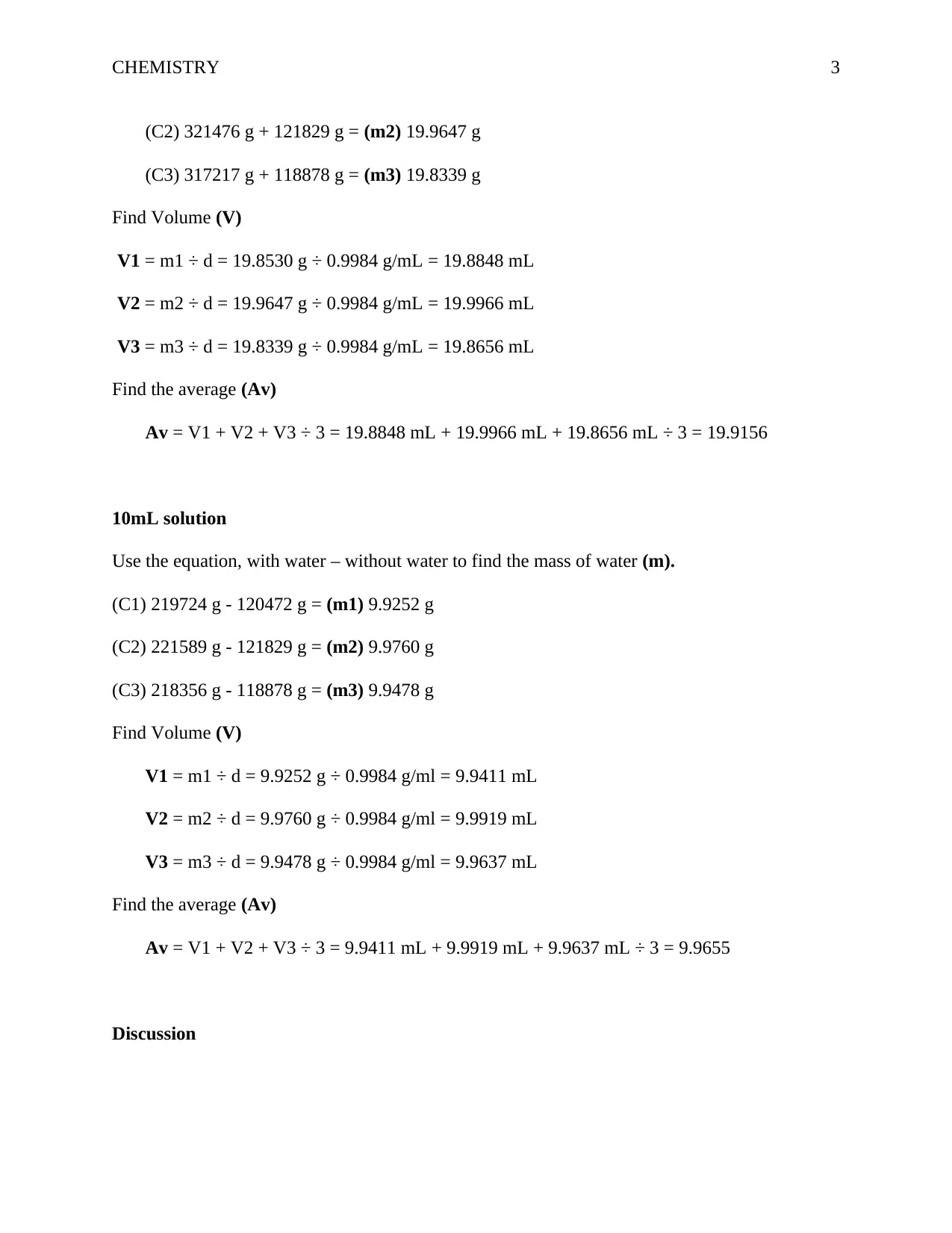
CHEMISTRY 3
(C2) 321476 g + 121829 g = (m2) 19.9647 g
(C3) 317217 g + 118878 g = (m3) 19.8339 g
Find Volume (V)
V1 = m1 ÷ d = 19.8530 g ÷ 0.9984 g/mL = 19.8848 mL
V2 = m2 ÷ d = 19.9647 g ÷ 0.9984 g/mL = 19.9966 mL
V3 = m3 ÷ d = 19.8339 g ÷ 0.9984 g/mL = 19.8656 mL
Find the average (Av)
Av = V1 + V2 + V3 ÷ 3 = 19.8848 mL + 19.9966 mL + 19.8656 mL ÷ 3 = 19.9156
10mL solution
Use the equation, with water – without water to find the mass of water (m).
(C1) 219724 g - 120472 g = (m1) 9.9252 g
(C2) 221589 g - 121829 g = (m2) 9.9760 g
(C3) 218356 g - 118878 g = (m3) 9.9478 g
Find Volume (V)
V1 = m1 ÷ d = 9.9252 g ÷ 0.9984 g/ml = 9.9411 mL
V2 = m2 ÷ d = 9.9760 g ÷ 0.9984 g/ml = 9.9919 mL
V3 = m3 ÷ d = 9.9478 g ÷ 0.9984 g/ml = 9.9637 mL
Find the average (Av)
Av = V1 + V2 + V3 ÷ 3 = 9.9411 mL + 9.9919 mL + 9.9637 mL ÷ 3 = 9.9655
Discussion
(C2) 321476 g + 121829 g = (m2) 19.9647 g
(C3) 317217 g + 118878 g = (m3) 19.8339 g
Find Volume (V)
V1 = m1 ÷ d = 19.8530 g ÷ 0.9984 g/mL = 19.8848 mL
V2 = m2 ÷ d = 19.9647 g ÷ 0.9984 g/mL = 19.9966 mL
V3 = m3 ÷ d = 19.8339 g ÷ 0.9984 g/mL = 19.8656 mL
Find the average (Av)
Av = V1 + V2 + V3 ÷ 3 = 19.8848 mL + 19.9966 mL + 19.8656 mL ÷ 3 = 19.9156
10mL solution
Use the equation, with water – without water to find the mass of water (m).
(C1) 219724 g - 120472 g = (m1) 9.9252 g
(C2) 221589 g - 121829 g = (m2) 9.9760 g
(C3) 218356 g - 118878 g = (m3) 9.9478 g
Find Volume (V)
V1 = m1 ÷ d = 9.9252 g ÷ 0.9984 g/ml = 9.9411 mL
V2 = m2 ÷ d = 9.9760 g ÷ 0.9984 g/ml = 9.9919 mL
V3 = m3 ÷ d = 9.9478 g ÷ 0.9984 g/ml = 9.9637 mL
Find the average (Av)
Av = V1 + V2 + V3 ÷ 3 = 9.9411 mL + 9.9919 mL + 9.9637 mL ÷ 3 = 9.9655
Discussion
Paraphrase This Document
Need a fresh take? Get an instant paraphrase of this document with our AI Paraphraser

CHEMISTRY 4
The pipette lab exercise enables students to exercise effective use of the lab equipment. It forms
a foundation that enables the students to develop a scientific thinking through developing
valuable experimental observations as well as analysis of existing theoretical data. From such
analysis, probable conclusions can then be made. From this activity, it becomes evident that the
size of the pipette has an influence on the volume uptake. The volume of the solution that
resulted to a more exact mass was falling within the volume range of the pipette ("A Guide to
Proper Pipetting | Lab Manager", 2019). This therefore justifies the need to abide by the
recommended range for the pipette that that is being used as well as choosing the most
appropriate pipette that will be used to deliver a given liquid volume. In a bid to raise the
precision while handling the pipette for various lab exercises, it is important to maintain the
volume of the solution pipetted within the recommended range of volume for the pipette used.
Allowing this leads to increased chances of obtaining pipetting errors that would further lower
the precision as well as skewed results.
The viscosity of the solution being used also plays a major role in the precision of the pipetting
results. Viscous solutions generally have a more reduced movement than water. This does not
only lower the release and uptake rate of the solution, but also raises the chances of obtaining air
bubbles in the pipette plastic tip. The pipette will therefore have a lower volume than what is
anticipated. Some of the solutions also move at a slow speed hence the possibility of having
some of the solution being left in the pipette. In either of the situations, the volume of the
solution that is finally massed will be less as compared to the anticipated mass. The volume of
the solution that is actually measured within all the trails could present several significant
differences. The differences imply that there will be a higher negative effect on the results in
terms of precision ("How to pipette – the essential guide to good technique", 2019).
The pipette lab exercise enables students to exercise effective use of the lab equipment. It forms
a foundation that enables the students to develop a scientific thinking through developing
valuable experimental observations as well as analysis of existing theoretical data. From such
analysis, probable conclusions can then be made. From this activity, it becomes evident that the
size of the pipette has an influence on the volume uptake. The volume of the solution that
resulted to a more exact mass was falling within the volume range of the pipette ("A Guide to
Proper Pipetting | Lab Manager", 2019). This therefore justifies the need to abide by the
recommended range for the pipette that that is being used as well as choosing the most
appropriate pipette that will be used to deliver a given liquid volume. In a bid to raise the
precision while handling the pipette for various lab exercises, it is important to maintain the
volume of the solution pipetted within the recommended range of volume for the pipette used.
Allowing this leads to increased chances of obtaining pipetting errors that would further lower
the precision as well as skewed results.
The viscosity of the solution being used also plays a major role in the precision of the pipetting
results. Viscous solutions generally have a more reduced movement than water. This does not
only lower the release and uptake rate of the solution, but also raises the chances of obtaining air
bubbles in the pipette plastic tip. The pipette will therefore have a lower volume than what is
anticipated. Some of the solutions also move at a slow speed hence the possibility of having
some of the solution being left in the pipette. In either of the situations, the volume of the
solution that is finally massed will be less as compared to the anticipated mass. The volume of
the solution that is actually measured within all the trails could present several significant
differences. The differences imply that there will be a higher negative effect on the results in
terms of precision ("How to pipette – the essential guide to good technique", 2019).
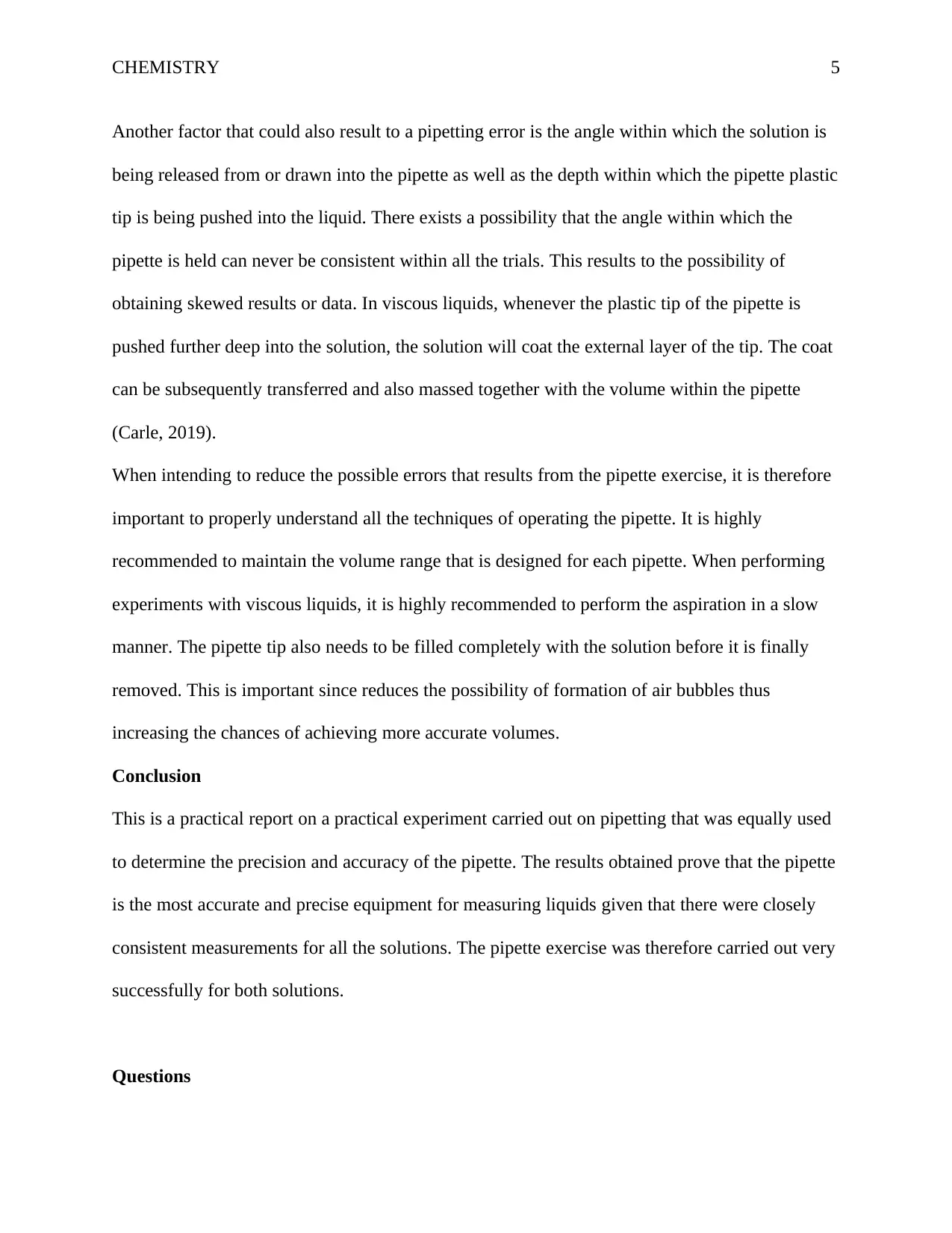
CHEMISTRY 5
Another factor that could also result to a pipetting error is the angle within which the solution is
being released from or drawn into the pipette as well as the depth within which the pipette plastic
tip is being pushed into the liquid. There exists a possibility that the angle within which the
pipette is held can never be consistent within all the trials. This results to the possibility of
obtaining skewed results or data. In viscous liquids, whenever the plastic tip of the pipette is
pushed further deep into the solution, the solution will coat the external layer of the tip. The coat
can be subsequently transferred and also massed together with the volume within the pipette
(Carle, 2019).
When intending to reduce the possible errors that results from the pipette exercise, it is therefore
important to properly understand all the techniques of operating the pipette. It is highly
recommended to maintain the volume range that is designed for each pipette. When performing
experiments with viscous liquids, it is highly recommended to perform the aspiration in a slow
manner. The pipette tip also needs to be filled completely with the solution before it is finally
removed. This is important since reduces the possibility of formation of air bubbles thus
increasing the chances of achieving more accurate volumes.
Conclusion
This is a practical report on a practical experiment carried out on pipetting that was equally used
to determine the precision and accuracy of the pipette. The results obtained prove that the pipette
is the most accurate and precise equipment for measuring liquids given that there were closely
consistent measurements for all the solutions. The pipette exercise was therefore carried out very
successfully for both solutions.
Questions
Another factor that could also result to a pipetting error is the angle within which the solution is
being released from or drawn into the pipette as well as the depth within which the pipette plastic
tip is being pushed into the liquid. There exists a possibility that the angle within which the
pipette is held can never be consistent within all the trials. This results to the possibility of
obtaining skewed results or data. In viscous liquids, whenever the plastic tip of the pipette is
pushed further deep into the solution, the solution will coat the external layer of the tip. The coat
can be subsequently transferred and also massed together with the volume within the pipette
(Carle, 2019).
When intending to reduce the possible errors that results from the pipette exercise, it is therefore
important to properly understand all the techniques of operating the pipette. It is highly
recommended to maintain the volume range that is designed for each pipette. When performing
experiments with viscous liquids, it is highly recommended to perform the aspiration in a slow
manner. The pipette tip also needs to be filled completely with the solution before it is finally
removed. This is important since reduces the possibility of formation of air bubbles thus
increasing the chances of achieving more accurate volumes.
Conclusion
This is a practical report on a practical experiment carried out on pipetting that was equally used
to determine the precision and accuracy of the pipette. The results obtained prove that the pipette
is the most accurate and precise equipment for measuring liquids given that there were closely
consistent measurements for all the solutions. The pipette exercise was therefore carried out very
successfully for both solutions.
Questions
⊘ This is a preview!⊘
Do you want full access?
Subscribe today to unlock all pages.

Trusted by 1+ million students worldwide

CHEMISTRY 6
1
Always ensure a tip is used when taking measurements with the pipette
Remember not to rotate the volume adjustor past the upper limit. This is because it could
result to a change in the calibration.
Adopt the right pipette for its appropriate functionality
The volume is adjusted by turning the plunger or the adjustment knob ("Pipetting
Technique: Operators as Sources of Error", 2019).
Follow the right procedure of withdrawing fluid from the tube
When expelling or withdrawing fluid, it is important to ensure that the tube is held firmly
between the forefinger and the thumb. It should also be held closer to the eye level in
order to enable observation of a change in the level of fluid in the tip
2
Incorrect tip of the pipette
Component failure such as corroded piston or a plunger seal
Improper tip installation
Differences in the shape and size of the sample container
The rate at which the plunger is released or depressed ("Sources of Error in Pipetting",
2019).
Constant delay between the removal and aspiration of the tip from the sample
3
The mean volume for the 20ml solution was calculated at 19.9156 whereas that of the 10ml
solution was at 9.9655. The difference when compared with the manufactures claim is acceptable
given that it falls within the allowed ± 0.05 range.
1
Always ensure a tip is used when taking measurements with the pipette
Remember not to rotate the volume adjustor past the upper limit. This is because it could
result to a change in the calibration.
Adopt the right pipette for its appropriate functionality
The volume is adjusted by turning the plunger or the adjustment knob ("Pipetting
Technique: Operators as Sources of Error", 2019).
Follow the right procedure of withdrawing fluid from the tube
When expelling or withdrawing fluid, it is important to ensure that the tube is held firmly
between the forefinger and the thumb. It should also be held closer to the eye level in
order to enable observation of a change in the level of fluid in the tip
2
Incorrect tip of the pipette
Component failure such as corroded piston or a plunger seal
Improper tip installation
Differences in the shape and size of the sample container
The rate at which the plunger is released or depressed ("Sources of Error in Pipetting",
2019).
Constant delay between the removal and aspiration of the tip from the sample
3
The mean volume for the 20ml solution was calculated at 19.9156 whereas that of the 10ml
solution was at 9.9655. The difference when compared with the manufactures claim is acceptable
given that it falls within the allowed ± 0.05 range.
Paraphrase This Document
Need a fresh take? Get an instant paraphrase of this document with our AI Paraphraser
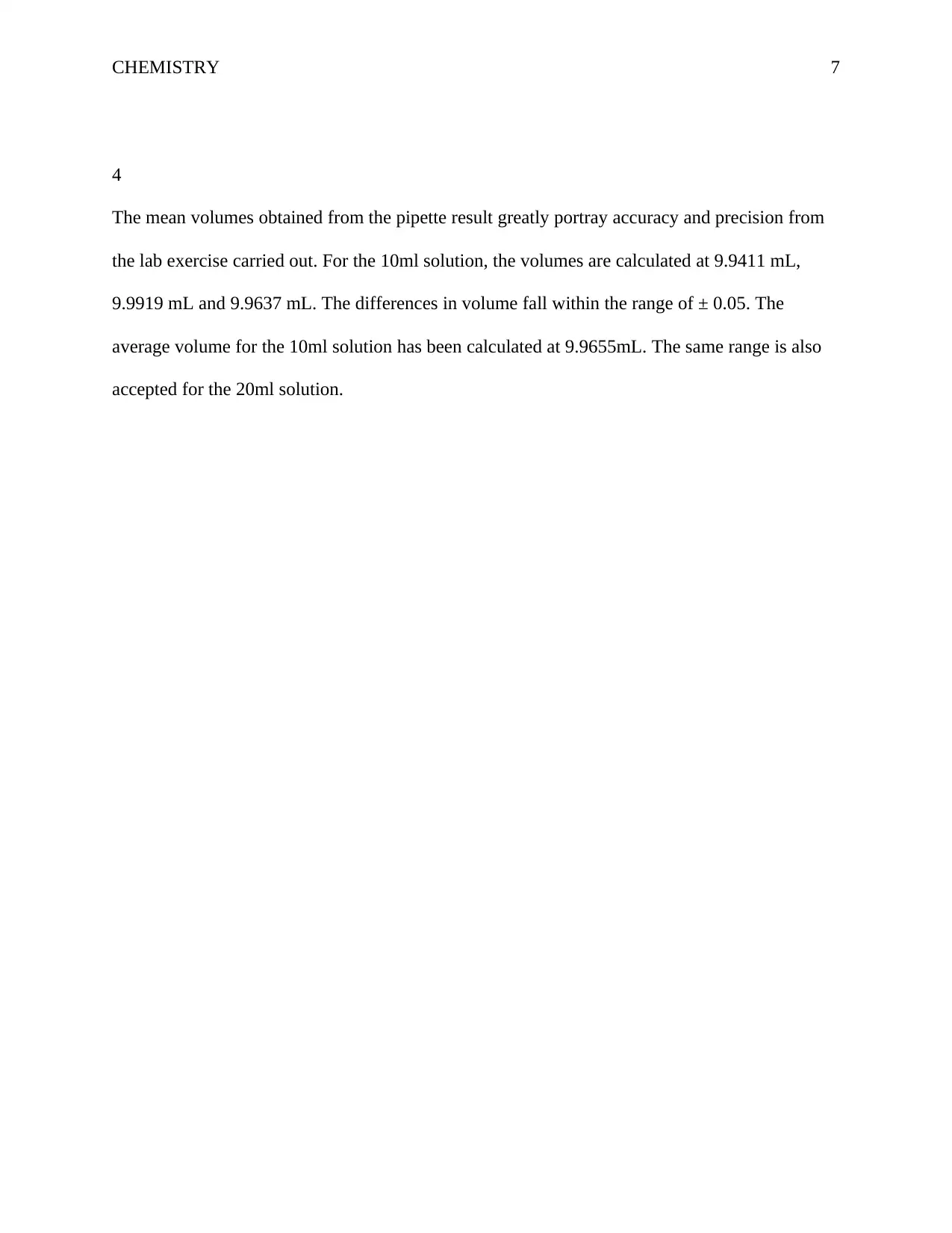
CHEMISTRY 7
4
The mean volumes obtained from the pipette result greatly portray accuracy and precision from
the lab exercise carried out. For the 10ml solution, the volumes are calculated at 9.9411 mL,
9.9919 mL and 9.9637 mL. The differences in volume fall within the range of ± 0.05. The
average volume for the 10ml solution has been calculated at 9.9655mL. The same range is also
accepted for the 20ml solution.
4
The mean volumes obtained from the pipette result greatly portray accuracy and precision from
the lab exercise carried out. For the 10ml solution, the volumes are calculated at 9.9411 mL,
9.9919 mL and 9.9637 mL. The differences in volume fall within the range of ± 0.05. The
average volume for the 10ml solution has been calculated at 9.9655mL. The same range is also
accepted for the 20ml solution.
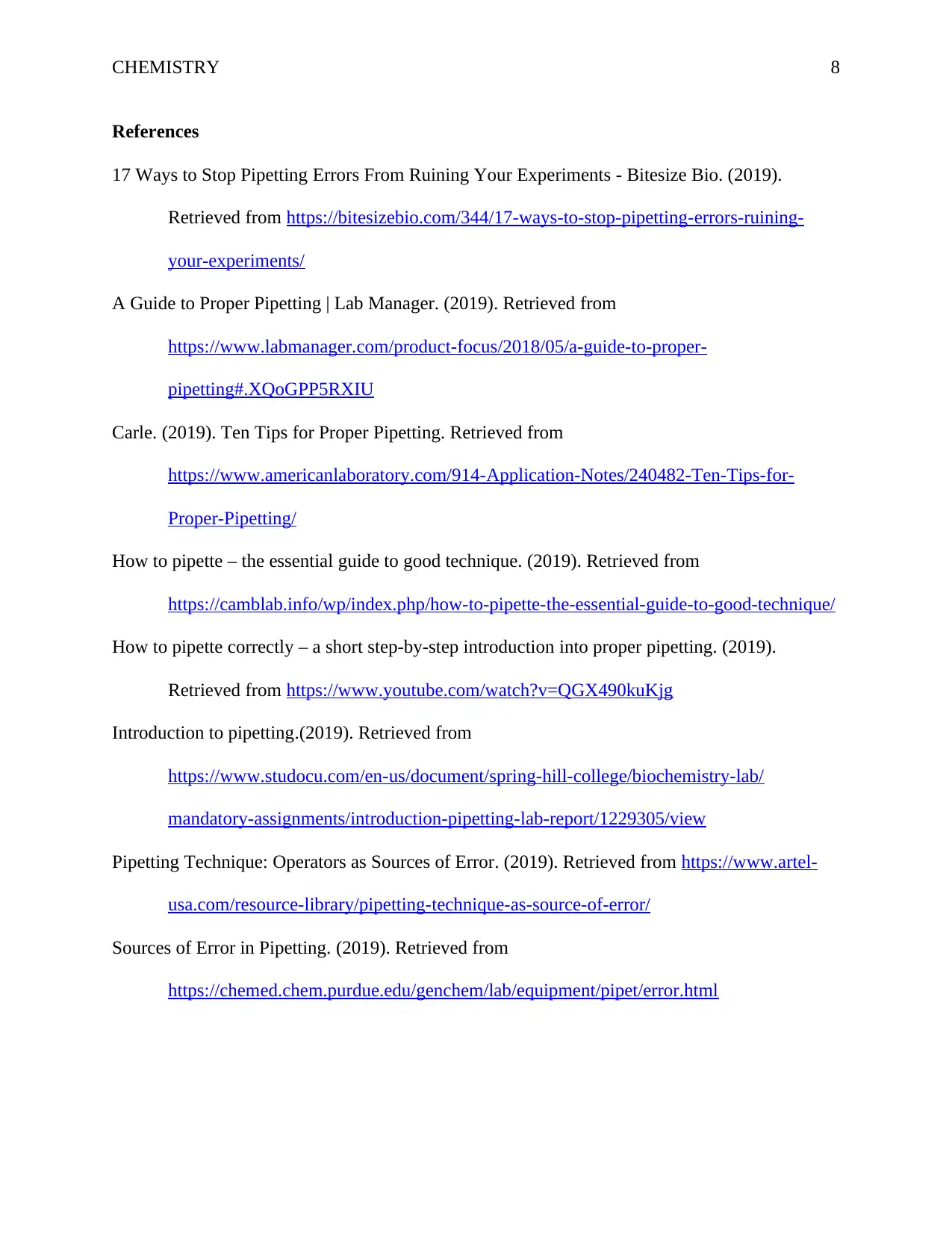
CHEMISTRY 8
References
17 Ways to Stop Pipetting Errors From Ruining Your Experiments - Bitesize Bio. (2019).
Retrieved from https://bitesizebio.com/344/17-ways-to-stop-pipetting-errors-ruining-
your-experiments/
A Guide to Proper Pipetting | Lab Manager. (2019). Retrieved from
https://www.labmanager.com/product-focus/2018/05/a-guide-to-proper-
pipetting#.XQoGPP5RXIU
Carle. (2019). Ten Tips for Proper Pipetting. Retrieved from
https://www.americanlaboratory.com/914-Application-Notes/240482-Ten-Tips-for-
Proper-Pipetting/
How to pipette – the essential guide to good technique. (2019). Retrieved from
https://camblab.info/wp/index.php/how-to-pipette-the-essential-guide-to-good-technique/
How to pipette correctly – a short step-by-step introduction into proper pipetting. (2019).
Retrieved from https://www.youtube.com/watch?v=QGX490kuKjg
Introduction to pipetting.(2019). Retrieved from
https://www.studocu.com/en-us/document/spring-hill-college/biochemistry-lab/
mandatory-assignments/introduction-pipetting-lab-report/1229305/view
Pipetting Technique: Operators as Sources of Error. (2019). Retrieved from https://www.artel-
usa.com/resource-library/pipetting-technique-as-source-of-error/
Sources of Error in Pipetting. (2019). Retrieved from
https://chemed.chem.purdue.edu/genchem/lab/equipment/pipet/error.html
References
17 Ways to Stop Pipetting Errors From Ruining Your Experiments - Bitesize Bio. (2019).
Retrieved from https://bitesizebio.com/344/17-ways-to-stop-pipetting-errors-ruining-
your-experiments/
A Guide to Proper Pipetting | Lab Manager. (2019). Retrieved from
https://www.labmanager.com/product-focus/2018/05/a-guide-to-proper-
pipetting#.XQoGPP5RXIU
Carle. (2019). Ten Tips for Proper Pipetting. Retrieved from
https://www.americanlaboratory.com/914-Application-Notes/240482-Ten-Tips-for-
Proper-Pipetting/
How to pipette – the essential guide to good technique. (2019). Retrieved from
https://camblab.info/wp/index.php/how-to-pipette-the-essential-guide-to-good-technique/
How to pipette correctly – a short step-by-step introduction into proper pipetting. (2019).
Retrieved from https://www.youtube.com/watch?v=QGX490kuKjg
Introduction to pipetting.(2019). Retrieved from
https://www.studocu.com/en-us/document/spring-hill-college/biochemistry-lab/
mandatory-assignments/introduction-pipetting-lab-report/1229305/view
Pipetting Technique: Operators as Sources of Error. (2019). Retrieved from https://www.artel-
usa.com/resource-library/pipetting-technique-as-source-of-error/
Sources of Error in Pipetting. (2019). Retrieved from
https://chemed.chem.purdue.edu/genchem/lab/equipment/pipet/error.html
⊘ This is a preview!⊘
Do you want full access?
Subscribe today to unlock all pages.

Trusted by 1+ million students worldwide
1 out of 9
Your All-in-One AI-Powered Toolkit for Academic Success.
+13062052269
info@desklib.com
Available 24*7 on WhatsApp / Email
![[object Object]](/_next/static/media/star-bottom.7253800d.svg)
Unlock your academic potential
Copyright © 2020–2025 A2Z Services. All Rights Reserved. Developed and managed by ZUCOL.